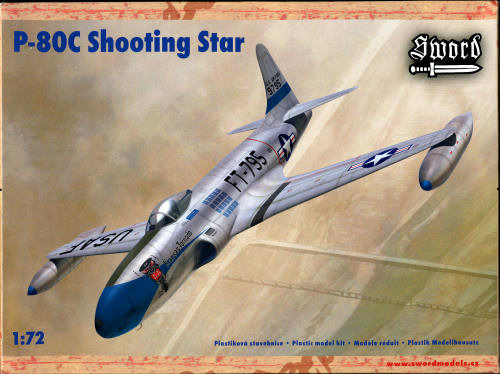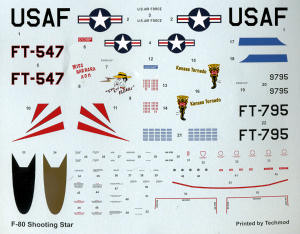
| KIT #: | SW72025 |
| PRICE: | $29.95 SRP |
| DECALS: | Two options |
| REVIEWER: | Scott Van Aken |
| NOTES: | New mold kit with resin parts |

| HISTORY |
The Lockheed P-80 Shooting Star was the first jet fighter used operationally by the United States Army Air Forces, and saw extensive combat in Korea with the United States Air Force as the F-80. As one of the world's first successful turbojet-powered combat aircraft, it helped usher in the "jet age" in the USAF and other air forces worldwide. One of its claims to fame is in training a new generation of pilots, especially in its closely-related, and actually faster, T-33 Shooting Star trainer development.
Shooting Stars first saw combat service in the Korean War, employing both the F-80C variant and RF-80 photo-recon variants. The first jet-versus-jet aircraft battle took place on 8 November 1950 in which Lieutenant Russell J. Brown, flying an F-80, claimed a MiG-15 shot down. Despite the initial claim of success, the straight-wing F-80s were inferior in performance to the MiGs and were soon replaced in the air superiority role by the swept-wing F-86 Sabre. When sufficient Sabres were in operation, the Shooting Star was assigned to ground attack missions, advanced flight training duties and air defense in Japan. By the end of hostilities the only F-80s still flying in Korea were photo-recon variants.
F-80Cs equipped ten USAF squadrons in Korea:
Of the 277 F-80s lost in operations (approximately 30% of the existing inventory), 113 were destroyed by ground fire and 14 shot down by enemy aircraft. F-80s are credited by the USAF with destroying 17 aircraft in air-to-air combat and 24 on the ground. MajorCharles J. Loring, Jr. was posthumously awarded the Medal of Honor for his actions while flying with the 80th Fighter-Bomber Squadron, 8th Fighter-Bomber Wing on 22 November 1952.
| THE KIT |
 Sword's F-80C (Incorrectly listed as a P-80C on the box) is the first new mold F-80 kit in 1/72 scale since the venerable Airfix version of the early 1970s. The kit includes two sprues of grey plastic (actually one sprue cut in half to fit into the box) a clear sprue with a separate windscreen and canopy, and a small bag of resin parts. These resin parts consist of the center main gear well, complete nose gear well, seat, gun sight and landing light section. I'm pretty sure the seat is the proper one for a Korean War plane. The resin is superbly done with considerable detail. It would have been nice to have the cockpit tub also in resin as the plastic detailing, while good, is not as nice as it would have been in resin. In fact, the plastic tub is somewhat generic without all the little details and panels as on the real aircraft.
Sword's F-80C (Incorrectly listed as a P-80C on the box) is the first new mold F-80 kit in 1/72 scale since the venerable Airfix version of the early 1970s. The kit includes two sprues of grey plastic (actually one sprue cut in half to fit into the box) a clear sprue with a separate windscreen and canopy, and a small bag of resin parts. These resin parts consist of the center main gear well, complete nose gear well, seat, gun sight and landing light section. I'm pretty sure the seat is the proper one for a Korean War plane. The resin is superbly done with considerable detail. It would have been nice to have the cockpit tub also in resin as the plastic detailing, while good, is not as nice as it would have been in resin. In fact, the plastic tub is somewhat generic without all the little details and panels as on the real aircraft.
Detailing on the plastic parts is excellent with fine engravings. I found flash on several pieces, but this is to be expected from what is really a short run kit. I also noted that the sprue attachment areas intrude into most of the parts so some care will be needed to remove the bits and to clean up these attachment areas. There are blanking plates for the intakes to prevent see-through and the kit comes with both Misawa and standard tip tanks. The majority of planes used the Misawa tanks. Speed brakes are separate items as well with all the appropriate retraction struts included. This is true of the main and nose gear legs. The nose gear has a separate wheel/tire piece. Two styles of nose wheel are provided, though most will use the later variant that is the same design as the main wheels. Still a good idea to check photos. The only ordn ance included are a pair of 500 lb bombs and racks. There are indentations on the underside of the wing for these racks. One would probably be wise to open them up a bit more to ensure a good fit.
ance included are a pair of 500 lb bombs and racks. There are indentations on the underside of the wing for these racks. One would probably be wise to open them up a bit more to ensure a good fit.
Instructions are well done with generic color references and indications as to what to paint the small bits during construction. Detail alignment information is given to be sure that we get things properly in position. Two options are given, with both aircraft in overall unpainted metal. First is the box art plane "Kansas Tornado" from 1951. No unit info is provided, but it is the 51st FIW. The second is "Eagle Eye Fleegle" from the 36 FBS/8 FBG in 1952. The decals are superbly printed by Techmod and provide either the OD or Black anti-glare panel for your option of choice. Full stencil suite is also provided. The blue on the 51 FIW plane will have to be painted on as will the red on the lower nose of the 36 FBS version. The very tips of the wing tanks are also in unit colors. No wing walk decals are given so paint will be required here as well.
| CONCLUSIONS |
So, if you have been waiting for a new mold 1/72 F-80C kit, your wait is over. With the release of this plane in 1/32 so recently done as well, one wonders if a new 1/48 version may be on the horizon.
| REFERENCES |
June 2009
Thanks to www.squadron.com for the preview kit. Get yours today at your local shop or on-line retailer
If you would like your product reviewed fairly and fairly quickly, please contact the editor or see other details in the Note to Contributors.